I tried 6 easy homemade face mask patterns. Here’s what happened.
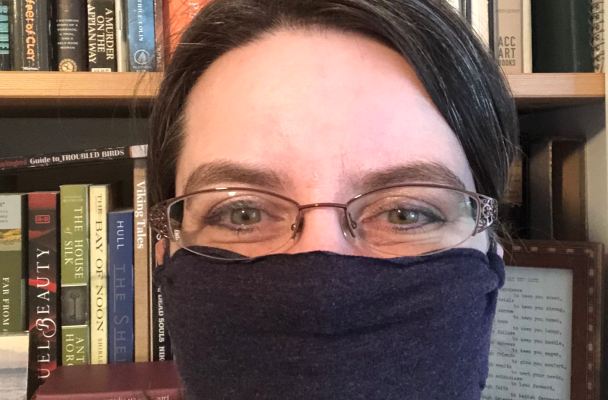
Photo: Shala Howell.
Update 12/11/2020: Since I first wrote this post two important things have changed
- The CDC now says that masks can protect both the wearer and the people around them. The amount of protection the wearer receives from their mask depends on the type of mask they wear. The CDC’s page includes some simple guidelines for masks. In general, they recommend snugly fitting, non-medical disposable face masks or cloth masks made of multiple layers of breathable, but tightly woven fabric, with a filter, if possible. Masks with valves are not recommended.
- There have been several studies published on the efficacy of various types of masks. This article from Hartford Healthcare, “Masks Save Lives“, reports on a Duke University study from August 2020 that tested the efficacy of a variety of masks, from medical grade N95s to those gaiters joggers in my area definitely prefer. TL;DR: No surprise, the N95s and surgical masks performed the best. Of the options available to us lay-folk, multiple layer cotton or polypropylene masks performed best. Gaiters and bandanas performed the worst.
Please keep that new information in mind when you read the rest of this post on DIY cloth masks you can make at home. After all, if you’re going to put in the effort to make one, you might as well spend the time making one that offers reasonable protection.
Now for my original post….
In April, reacting to evidence that asymptomatic people can spread COVID-19, the CDC began asking Americans to wear masks in addition to maintaining physical distancing whenever they were out in public, regardless of whether they felt sick.
Here’s the counterintuitive thing about masks:
Wearing masks will save lives, but the life you save may not be your own.
That’s because while masks are useful for keeping infectious particles from exiting your nose and mouth, they are less effective at keeping infectious particles from entering your nose and/or mouth. That’s why public health officials want us to maintain physical distancing, wash our hands alot, and avoid touching our faces even if we are wearing a mask.
I don’t know how the guidance around masks is being implemented in your area, but our local public health officials have started requiring us to wear masks when we are out in public, unless we are exercising in an outdoor area where we can maintain proper physical distancing.
We are still being asked to use cloth masks and leave the surgical masks and N95s to medical professionals, essential workers, and first responders, so that means sourcing cloth masks from somewhere.
There are a ton of handmade mask patterns out there. Luckily my habit of starting and abandoning various types of crafting projects over the years has left me with a generous supply of quilting fabric, bias tape, elastic, thread, bandanas, old t-shirts, and flannel lying around the house.
So I decided to put some of those raw materials to work by making and reviewing 6 so-called easy cloth face mask patterns floating around online for you here on Caterpickles.
The 6 DIY patterns I tried, ranked according to comfort and how long it took to make them
This scatterplot ranks the six DIY masks I included in this post according to how easy they were to make and how comfortable they are to wear. (Note: It does not take into account how effective they might be.)

Option 1: Bandana tied around my neck cattle-rustler style (no-sew)
This seems pretty self-explanatory, but in case you are curious, here’s a photo of Tim Kaine rocking the cattle-rustler bandana in the Senate a few weeks ago.
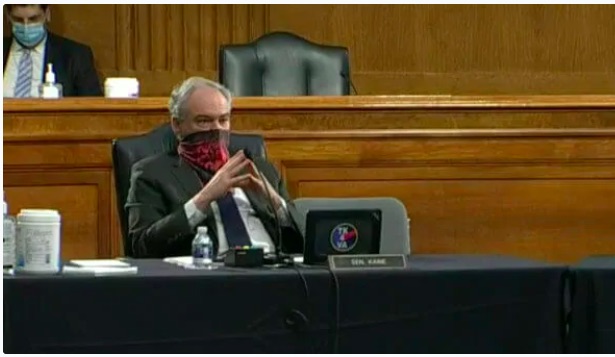
What is it like to make?
This literally takes 30 seconds, and is by far the easiest of the options.
Step 1: Spread the bandana out onto a flat surface.
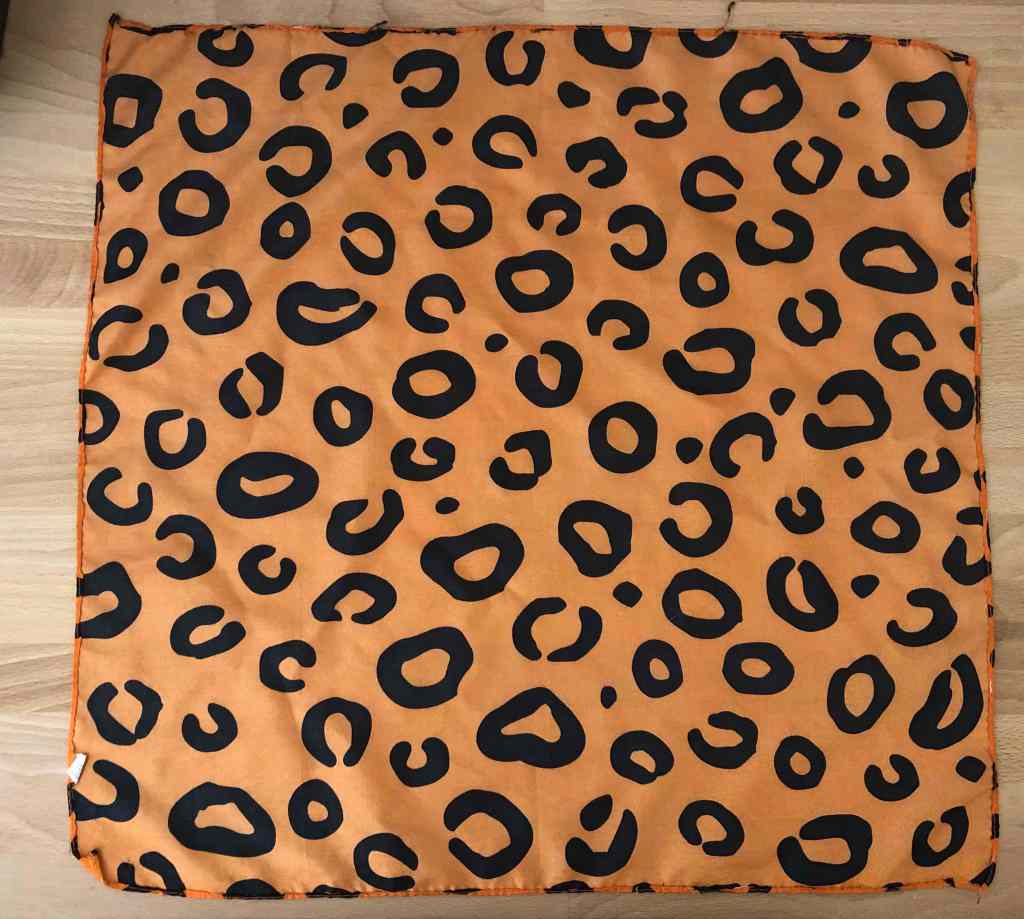
Step 2: Fold it into a large triangle by placing the upper right hand corner on top of the lower left hand corner.
Step 3: Tie the long ends of the triangle around the back of your neck.
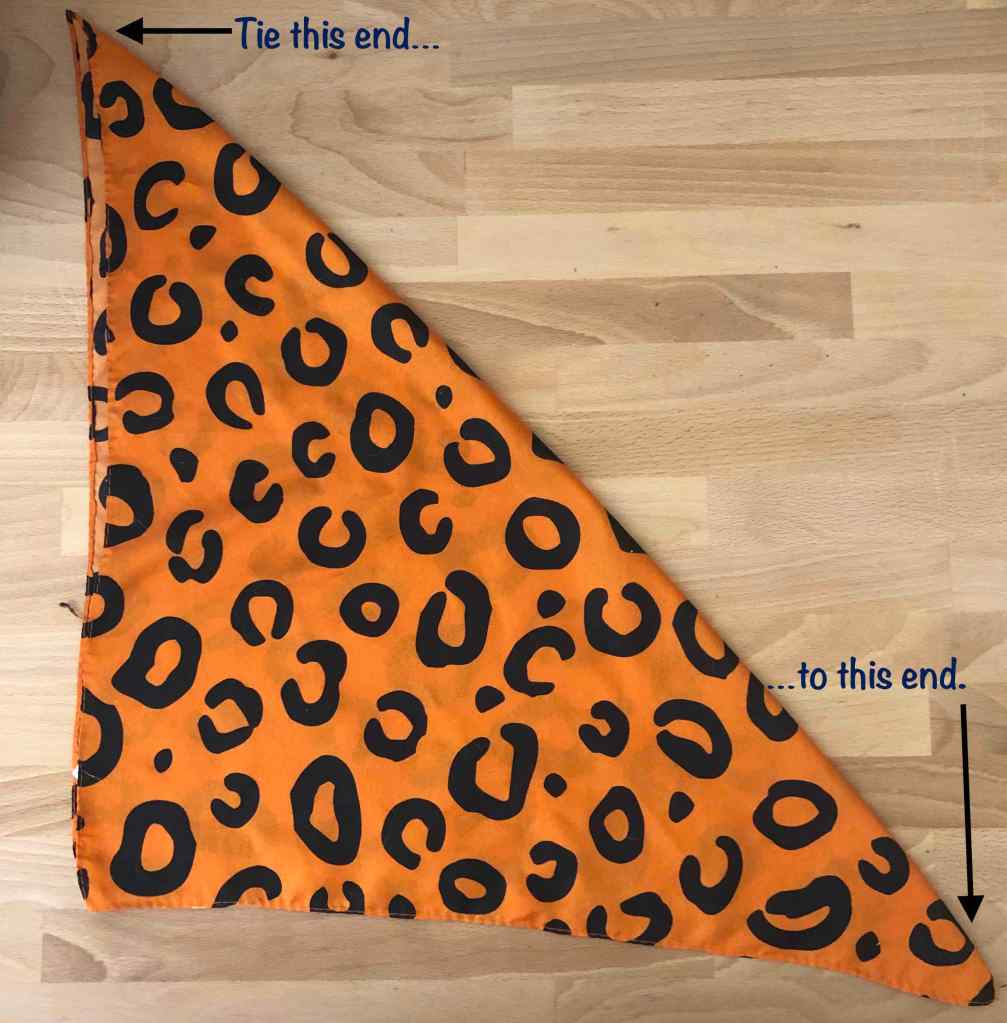
Step 4: Pull the bandana up so it covers your nose and mouth.
And you’re done.
What is it like to wear?
One issue to be aware of when making a rapid-tie bandana face mask is that bandanas come in different sizes.
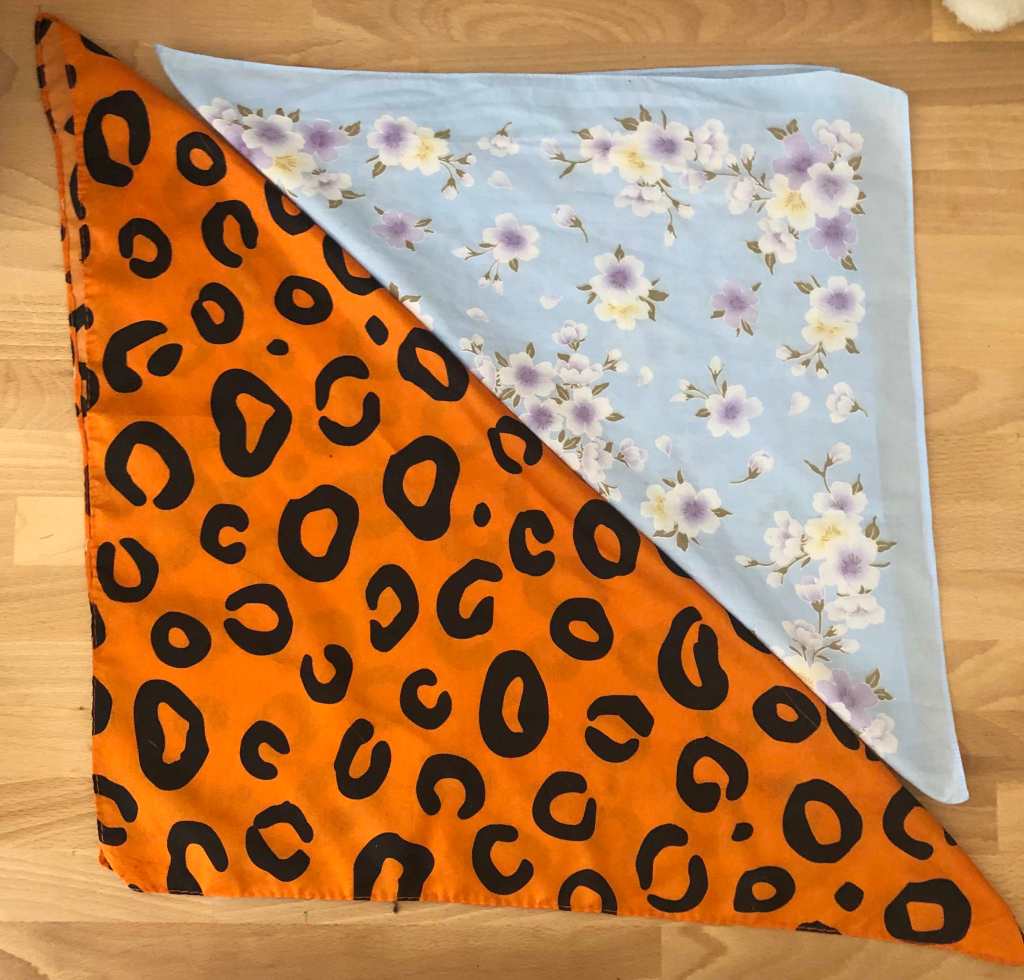
The Thirteen-Year-Old can use either bandana in this picture, but my husband can only use the orange one. So check the size of your bandanas sometime before you need to walk out the door.
Assuming you can find a bandana that fits around your head and not just your neck, these are very easy to wear.
I like using a bandana tied this way when I’m going to be outdoors anyway, in an area where I will have plenty of room to dodge oncoming people, but may not need to wear a mask 100% of the time. This style allows me to keep the bandana hanging around my neck when no one’s around, and just pull it up quickly if I see someone coming.
I wouldn’t go shopping in one, though.
Effectiveness Best Guess: ¯\_(ツ)_/¯
What am I? A particulate testing lab?
That said, my husband found this article in Science Daily about the work the University of California – Irvine is doing in their particulate testing lab. The tests they have run so far on various DIY mask materials show that bandanas are essentially useless for anything other than blocking the large particles emitted when you sneeze. Bummer. You can find more of the UCI testing lab’s findings on their web site.
In what I can only assume was an attempt to further rub in the bad news, my husband also sent me a study by Larry Bowen at the Southern Research Institute in Birmingham, Alabama. Bowen’s study, which was published in Applied Biosafety, compared the utility of bandanas to surgical masks, dust masks, and N95s. Not surprisingly, the N95 outclassed everything with an efficiency rating of 89.6% (the bandana scored a mere 11.3%).
Option 2: Folded bandana with hair ties (no-sew)
Next up, the CDC’s pattern for making a quick face mask using a folded bandana and two elastic hair bands.

What was it like to make?
The more you make these, the faster you’ll get, but even when I made it for the first time, it only took a few minutes to fold the bandana and arrange it on my face.
What is it like to wear?
I used my stash of smaller bandanas for this style because there is less fabric to deal with while folding. By the time I had folded and arranged the mask, I was breathing through 9 (!) layers of fabric.
Because the mask hooks behind my ears, instead of tying around my face, it doesn’t interfere with my hair. My glasses, however, frequently get caught in it, and if I’m not careful, I end up taking my glasses off along with my mask.
The 9 fabric layers create a bulky mask that’s harder to keep properly arranged than a bandana tied cattle-rustler style. I’m not great at folding fabric at the best of times, and wearing a mask on my face for an hour is not the best of times. The bottom folds dropped out fairly quickly, prompting me to tuck them back in, and before I knew it, I was touching my face. Oops.
This style of mask was hard enough for me to breathe through that I wouldn’t want to wear it all-day or while walking or biking. I might use it on a quick shopping trip, but I wouldn’t want to wear it anywhere I would need a mask for more than 30 minutes.
That said, this might be a pretty handy option for emergencies. I can easily see keeping a spare bandana and elastic hair bands in my purse, tote bag, car, or luggage for impromptu use while I’m out and about. Right now, I don’t have the luxury of taking masks I like better out of the regular rotation like that.
Effectiveness Best Guess: ¯\_(ツ)_/¯
What am I? A particulate testing lab?
Option 3: T-shirt mask, with separate ties and face piece (no-sew)
This style is made using the same principles as Option 2: a strip of cloth folded around two separate ties before attaching it to your head.
I made mine from Jan Howell’s YouTube video tutorial: DIY Face Mask, No Sew, Upcycled T-Shirt. I chose this one because I wanted to end up with a comfortable, machine-washable mask with multiple layers. The downside of this design is that you end up with a mask that has three parts to it, and you have to re-fold it each time you put it on. I can already tell that keeping track of those mask ties is going to be a challenge for our family.
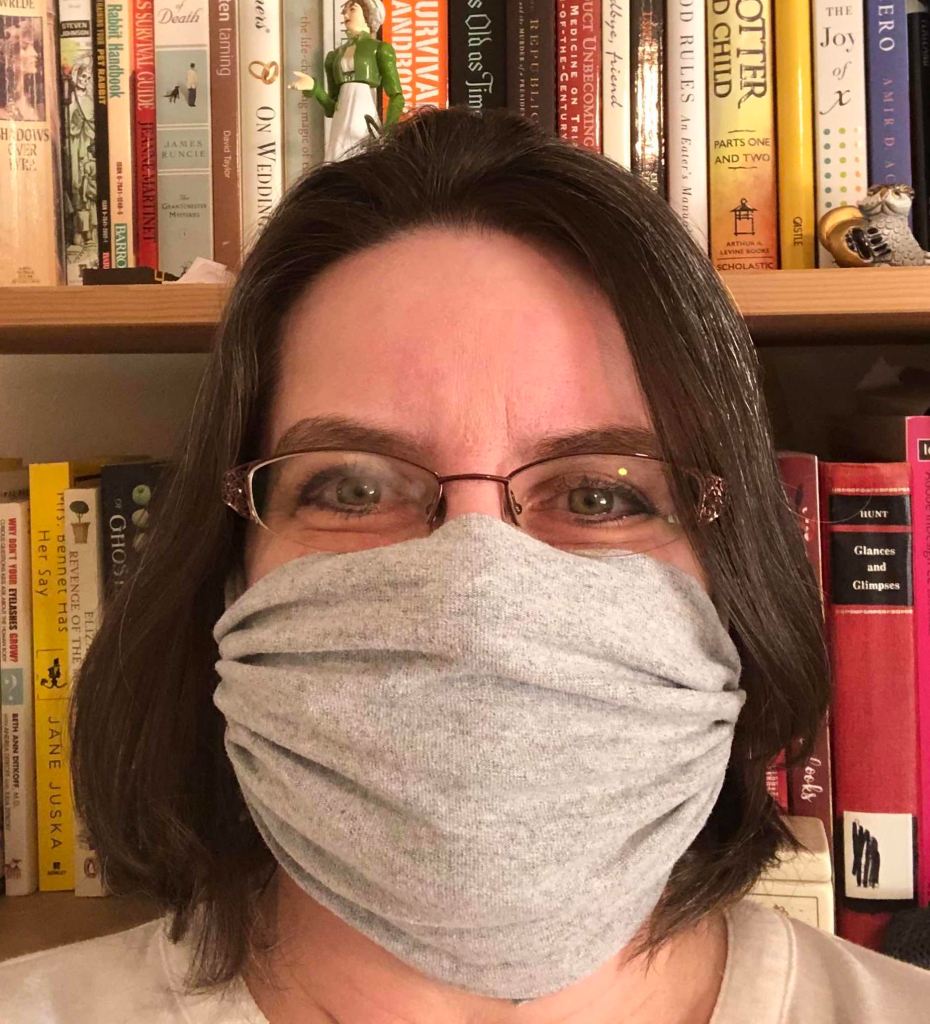
What was it like to make?
Jan Howell’s tutorial was straightforward and easy to follow. The hardest part for me was finding a t-shirt I was willing to sacrifice, and then actually convincing myself to cut it up.
Once I made it past those hurdles, I was able to create 4 masks in about 20 minutes from a single large men’s cotton t-shirt.
What is it like to wear?
This mask is very comfortable. Once folded, it creates a 2-3 layer mask (2 layers over the cheeks, sides of the mouth, and chin, 3 over the nose and middle of the mouth).
It’s relatively easy to shape, and the soft fabric means it doesn’t irritate my skin.
On the breathability scale, it falls between the cattle-rustler bandana and the folded bandana with hair ties. I could probably wear this mask all-day, while shopping, or while taking a walk. I likely wouldn’t want to wear it while hiking or biking.
Sadly, my hair turns out to be exactly the wrong length for this type of mask. If my hair were much shorter or much longer, the ties wouldn’t bother me, but as it is, when I tried to tie the mask around my neck, I kept getting my hair caught in the ties. It made the mask harder to fit properly, and was occasionally quite painful.
As a result, no matter how much I fiddled with it, I wasn’t able to get a perfect fit, as you can see from the fog on my glasses in the picture. Still, this mask is comfortable to wear for longer periods of time.
Effectiveness Best Guess: ¯\_(ツ)_/¯
What am I? A particulate testing lab?
My husband, who is clearly better at this scientific rigor thing than I am, came to my rescue again. This time he found an abstract for a study published in Disaster Medicine and Public Health Preparedness. The 2013 study by Davies etal compared the effectiveness of homemade t-shirt masks against surgical masks and wearing no mask at all. Not too surprisingly, the study showed that the surgical mask performed three times better than the mask made of t-shirt cotton. However, wearing a t-shirt mask was definitely better than wearing nothing at all when it came to the spread of germs through droplet transmissions. The study authors’ conclusion?
“Our findings suggest that a homemade mask should only be considered as a last resort to prevent droplet transmission from infected individuals, but it would be better than no protection.”
Davies, A., Thompson, K., Giri, K., Kafatos, G., Walker, J., & Bennett, A. (2013). Testing the Efficacy of Homemade Masks: Would They Protect in an Influenza Pandemic? Disaster Medicine and Public Health Preparedness, 7(4), 413-418. doi:10.1017/dmp.2013.43
Option 4: One piece, dual layer t-shirt mask (no-sew)
The other major t-shirt mask pattern I found does not require either sewing or separate ties. To make mine, I followed this kid-friendly tutorial for a double-layer, one-piece t-shirt mask from The Handwork Studio. This design has a place to tuck a filter, in case you’d like to use one.

What was it like to make?
The Handwork Studio’s tutorial was very easy to follow. I especially appreciated how she used a template to both measure the size of my face and eliminate measuring tapes. This helped me make a mask big enough to work while keeping me from going nuts with multiple bouts of measuring at each step.
(I tend to go a little crazy with measuring and remeasuring when I use anything with inches and centimeters actually marked on it. Working with a template means I measure obsessively just the one time and that makes the entire project go faster.)
The size of the t-shirt determines the length of the ties, so while I could have just tied additional fabric onto the original ties to make them long enough to tie around my head, I decided to start with the largest t-shirt I could find instead.
The directions involve cutting through four layers of fabric at once, which was fine for me because I have fabric scissors. It might not work for people who are trying to repurpose their paper scissors, since paper scissors are often too dull to cut multiple layers of fabric cleanly.
I also thought it was clever to knot the straps close to the face portion of the mask to hold the layers of fabric in the finished mask together without sewing.
Making the mask probably took ten minutes from start to finish. I spent a good chunk of that time measuring and remeasuring my template, so now that I’ve made my template, making future masks would be even faster.
What is it like to wear?
Texture-wise, this mask is the most comfortable mask so far. The super soft fabric of the t-shirt I picked means it doesn’t irritate my skin.
Adjusting the mask is as simple as making sure my nose and chin are covered once I’ve tied it. Super straightforward. Because the layers are flat pieces of fabric and not created by folding, this mask was much easier to tuck under the rim of my glasses to reduce fogging (and presumably improve the fit of the mask). I’m also not worried about any folded layers dropping out while I’m wearing it, which means I’m less likely to touch my face while I’m out and about.
On the breathability scale, this mask falls between the cattle-rustler bandana and the folded bandana with hair ties. I could wear this mask all day, while shopping, or while taking a walk. I may not want to wear it while hiking or biking.
Oddly, my hair did fine with this mask. Maybe I’m just getting better at tying masks around it?
Effectiveness Best Guess: ¯\_(ツ)_/¯
What am I? A particulate testing lab?
Option 5: Two-Layer Cloth Mask Contoured
For the first of my sewn masks, I followed this Youtube tutorial/pattern from Crafty Daily to make the mask. I picked it because it didn’t require me to break out the sewing machine. I used a combination of quilting cotton and flannel to make my mask. The ties tuck around my ears and are made of elastic.

What was it like to make?
The tutorial I followed used a dinner plate as the template for the fabric cutting stage, which neatly bypassed my measuring issues.
I was worried all that hand-sewing would be tedious, but the mask worked up much faster than I expected. Still, because I am pretty slow at hand-sewing, this one took me a couple of hours.
What is it like to wear?
The flannel lining is incredibly soft. I haven’t tried to wear it on a truly hot day yet, so I don’t know how comfortable it would be in summer or in a hotter climate. I could imagine that I wouldn’t want any contact with flannel on a hot summer day.
The elastic fits neatly over my ears, so this mask doesn’t interact with my hair at all. It does tend to snag my glasses, though, so I have to be careful when taking it off.
Finally, because I made it myself, I could cut different lengths of elastic for each mask wearer. That meant I could make the elastic long enough to achieve a close fit without pulling on ears too badly.
That resulted in a mask that I could wear all day at work or while shopping. I probably could wear it while exercising, but I’m pretty sure I wouldn’t enjoy it.
This style is The Thirteen-Year-Old’s favorite, by the way.
Effectiveness Best Guess: ¯\_(ツ)_/¯
What am I? A particulate testing lab?
I found a few articles online that claim that combining quilting cotton with some other fabric creates a mask with a pretty good filtration capability. Take this study by the ACS Nano, which found that combining quilting cotton + flannel can create a mask with a filtration efficiency of around 95%. That sounds great.
But fit really matters. A poor fit can reduce filtration efficiency by 60%. Ouch. Since this mask doesn’t have a wire in it to fit it more tightly around my nose, there are gaps.
If you don’t mind using a sewing machine, Georgia Tech has a pattern on their site that is similarly shaped and incorporates a wire along the nose to make the mask fit better.
Option 6: Two-Layer Cloth Mask with Ties
Based on this pattern from the CDC, using quilting cotton and flannel, but sewn by hand, instead of on a sewing machine. I made the ties from fabric bias tape.
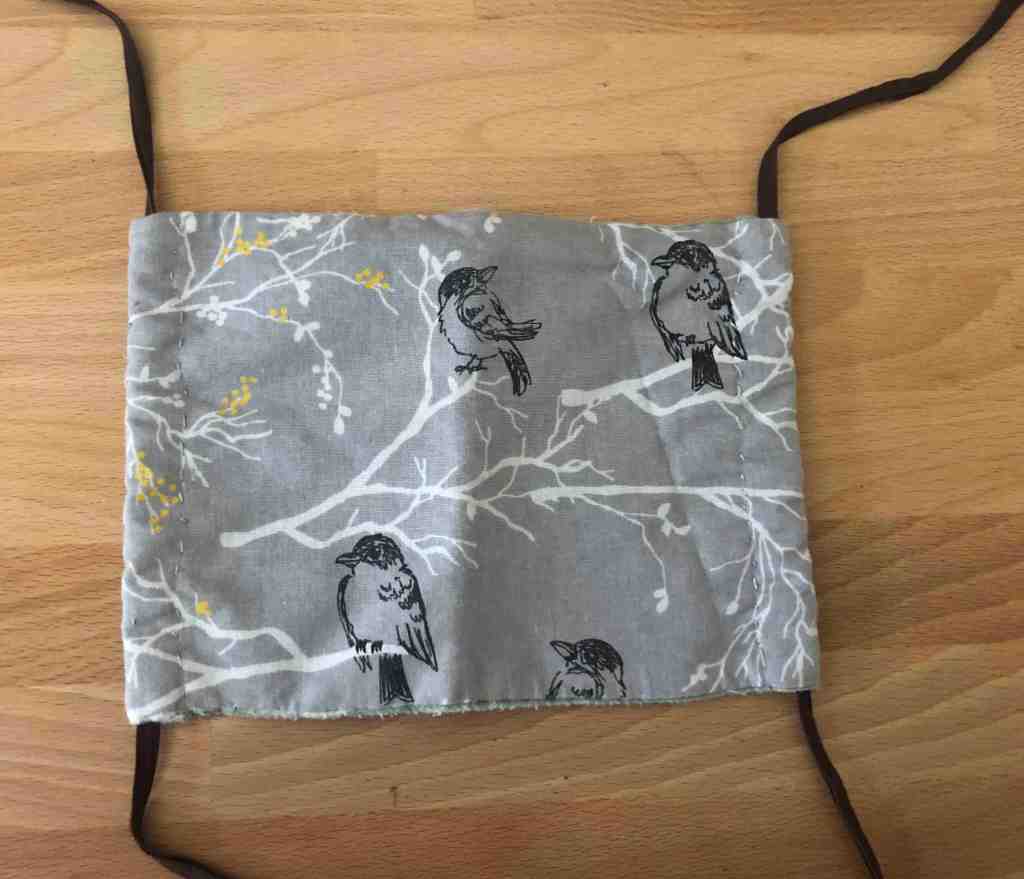
What was it like to make?
Honestly, this one wasn’t bad either. It has more hand-sewing than Option 5, but cutting and sewing along straight lines is easier than working along curves, so it sort of evened out.
Like Option 5, making this mask took a while — maybe an hour and half per mask. It’s a little hard for me to say exactly how long it took, because although I spent an afternoon making them, I cut pieces for several masks at once. After 4 hours, I had cut pieces for 4 masks, but had only actually finished 2. (Did I mention that I sew very slowly by hand?)
I imagine that I could crank these out pretty quickly if I weren’t too stubborn to break out the sewing machine.
What is it like to wear?
This mask is my husband’s favorite. It’s large enough to completely cover all the bits of his face that need covering, and the ties make it fit like the surgical masks he’s used to from his days in the ICU.
In addition, because this mask uses ties, it doesn’t pull on his ears at all, making it much more comfortable for long-term wear.
I like the fit on the contoured cloth face mask better (Option 5), but I wouldn’t hesitate to use this mask when running errands or working out in the world all day. I may not want to use it while hiking or biking, though. Wearing flannel while exercising in the summer sun doesn’t sound great.
Effectiveness Best Guess: ¯\_(ツ)_/¯
What am I? A particulate test lab?
What about you?
Are you being asked to wear masks where you are? If so, what kind works best for you?
Further reading, if you like that sort of thing
Articles on whether wearing masks helps
- Recommendation regarding the use of cloth face masks, particularly in areas of significant community-based transmission (CDC)
- Use of cloth face coverings to slow the spread of COVID-19 (CDC)
- DIY masks may not protect you from COVID-19. But here’s why it’s smart to wear one (ABC news)
- COVID-19: How much protection do face masks offer? (Mayo Clinic)
- If 80% of Americans wore masks, COVID-19 infections would plummet, new study shows (Vanity Fair)
Articles about making masks at home
- How to make masks for patients (Newman Regional Hospital)
- Option 2: Folded bandana with two hair ties (CDC)
- Option 3: DIY Face Mask, No Sew, Upcycled T-Shirt (Jan Howell via YouTube)
- Option 4: One-piece, dual layer no-sew T-shirt mask (The Handwork Studio)
- Option 5: Two-Layer Cloth Mask, Contoured (Crafty Daily)
- Option 6: Two-Layer Cloth Mask with Ties, based on Sewn Cloth Face Covering (CDC)
- DIY Two-Layer Cloth Mask pattern (Georgia Tech)
Articles on mask materials
Several articles rating the effectiveness of various materials commonly used in DIY cloth face masks have been published online, including:
- The best material for homemade masks may be a combination of two fabrics (Science Daily)
- Finding Effective Face Mask Fabrics for DIY Protective Coverings – “Bandanas Useless” (Science Daily)
- University of California – Irvine’s Face Mask Project (Test results and recommendations for mask designs)
- Does that face mask really protect you? (Applied BioSafety)
- Testing the efficacy of homemade masks: Would they protect in an Influenza Pandemic (Cambridge University Press)
- A cluster, randomized trial of cloth masks compared with medical masks in healthcare workers (BMJ Open)
- After watching the surgeon general’s video on making face mask, doctor sent him research on the best fabrics to use (Market Watch)
- Filtration engineers offer advice on do-it-yourself face masks (Georgia Tech)
- Aerosol Filtration Efficiency of Common Materials used in Respiratory Cloth Masks (ACS Nano)
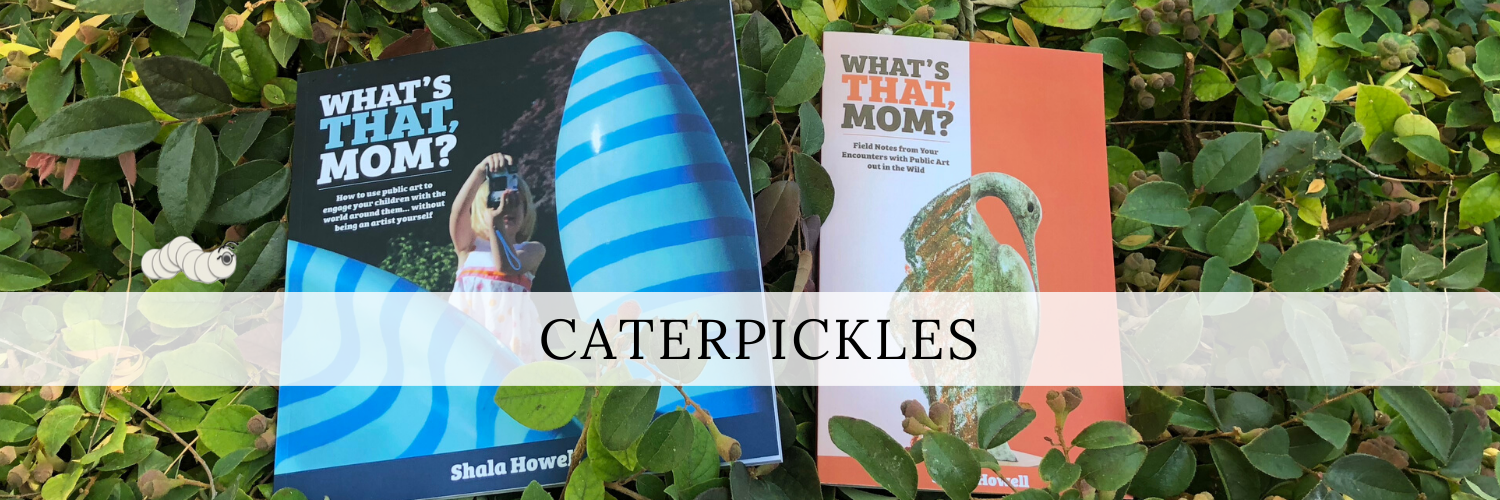
4 Responses to “I tried 6 easy homemade face mask patterns. Here’s what happened.”
This is awesome and informative! I love the graph too! Thank you for your research!
LikeLike
Thanks! It was a fun project. Hopefully, you’ll find a mask that works for you and your family. Thanks for stopping by Caterpickles and stay well. Congratulations to your girls on their graduation, btw.
LikeLike
My wife was in the elevator at Sam’s Town Friday with three other people who weren’t wearing masks. They taunted her for wearing it. She told them she was Typhoid Mary and was willing to take her mask off. The shut right up! Jerks.
LikeLike
Good for her. I am appalled that masks have been turned into a political issue, when they should be a simple matter of public health and caring for each other as a community during a pandemic. Stay well.
LikeLike